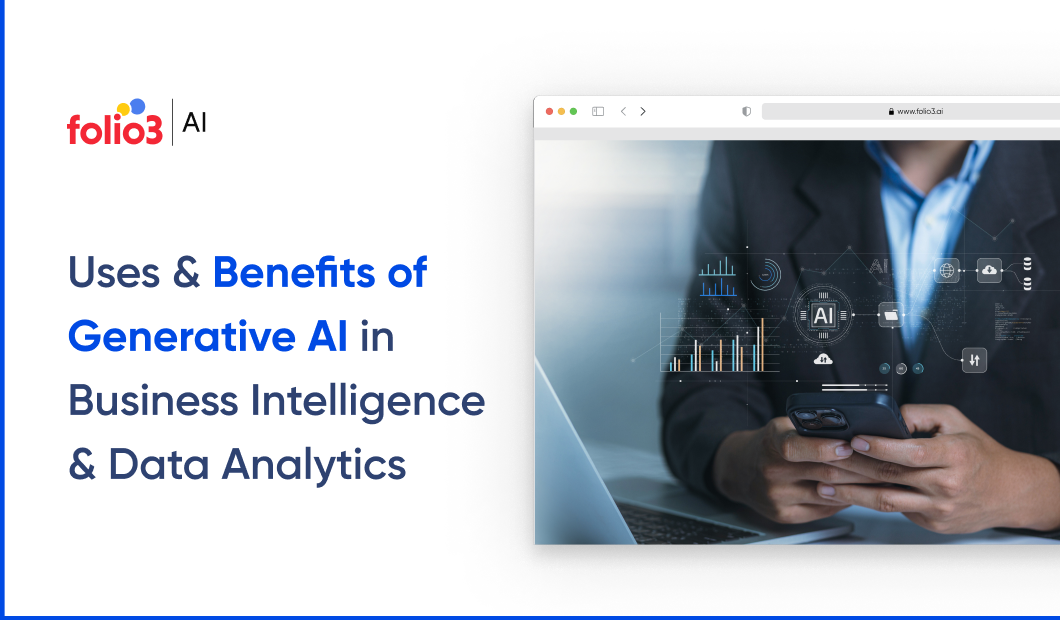Generative AI in Business Intelligenc is gaining momentum as time passes, and you may have already encountered it through tools like ChatGPT, highlighting its significance. Consider generative AI as intelligence available as a service a vast, ever-learning digital brain that anyone can access and interact with. While it’s not perfect and can make mistakes, its capabilities are improving exponentially.
Among the many benefits and use cases of generative AI, one of the most transformative is its application in business intelligence (BI) and data analytics. In this article, we will examine how Generative business intelligence contributes to these fields, enabling organizations to maintain a competitive advantage in an increasingly data-driven world.
What is Business Intelligence
Let’s quickly understand business intelligence (BI) first. BI encompasses organizations’ practices and processes for collecting, preparing, analyzing, and presenting data.
The ultimate goal is to transform raw data into actionable insights that drive informed decision-making. BI tools are critical in this process, helping businesses integrate, visualize, and interpret data effectively.
From data integration to decision-making, BI involves various roles and personas. Data engineers handle data extraction and transformation, analysts interpret insights, and executives or decision-makers use these insights to chart a strategic course.
The whole collaborative process ensures that data is not just stored but actively leveraged to create value.
Another term we can’t overlook before getting into the Generative AI for business intelligence’s main benefits and use cases is data analytics.
While BI focuses on the “what” and “how” of data-driven decision-making, data analytics dives deeper into the “why” and “what’s next.”
Data analytics involves exploring data patterns, forecasting trends, and identifying correlations that might otherwise go unnoticed.
It complements BI by providing predictive and prescriptive insights, making data a powerful strategic tool.
Now that we’ve understood BI and data analytics, let’s explore how generative business intelligence is reshaping these domains and offering exceptional potential.
Generative AI for Business Intelligence
Generative AI for Business Intelligence (BI) transforms how organizations use data to make decisions. While traditional BI tools focus on analyzing past data to drive decisions, generative AI goes a step further by automatically generating new insights, forecasts, and recommendations from the data.
GEN-AI in business intelligence makes this tool advanced and uses machine learning, deep learning, and natural language processing to find patterns, predict trends, and even simulate potential business scenarios.
This capability not only speeds up the process of decision-making but also reduces the reliance on human analysts.
Generative AI can also automate the generation of reports, enhance predictive analytics by forecasting future trends, and fill gaps in data with synthetic data.
More than that, it uses natural language processing to make complex BI insights more accessible to non-technical stakeholders.
Ultimately, generative AI empowers businesses to make more dynamic and data-driven decisions, turning raw data into valuable strategic tools that improve overall business outcomes.
Finally, generative AI automates various aspects of data analysis, from data preparation to generating insights and reports, which speeds up the analytics process and reduces human error.
By integrating these capabilities, organizations can have new opportunities for growth and innovation in an increasingly data-driven world.
Generative AI for Data Analytics
Generative AI has also changed the way we approach data analytics, making it faster, smarter, and more efficient.
Unlike traditional methods that require a lot of manual effort and predefined models, generative AI takes things to the next level.
It uses advanced technologies like machine learning and natural language processing to analyze massive datasets, uncover hidden patterns, and even predict trends.
What’s even cooler? It can create synthetic data to fill gaps, which means you get more complete and accurate results.
Plus, it presents insights in simple language, so even non-technical folks can understand complex data.
By automating tasks like data preparation and reporting, generative AI cuts down on errors and speeds up the entire process, giving businesses the tools they need to make better decisions and stay ahead in a data-driven world.
5 Main Uses of Generative AI in Business Intelligence & Data Analytics
1. Automate Analytics
Generative AI for Business Intelligence is changing how organizations approach analytics by automating time-consuming and repetitive tasks.
Traditionally, analyzing large datasets required manual sorting, filtering, and pattern identification a process prone to human error and inefficiency.
With Generative AI for Business Intelligence, businesses can process vast amounts of data in real-time, uncovering insights that would take days or weeks to generate through conventional methods.
It enables teams to focus on higher-value activities like strategic planning and decision-making while AI handles the heavy lifting of data analysis.
For example, we all use Netflix. They use Generative AI for Data Analytics to analyze user viewing habits and preferences, delivering personalized recommendations that engage viewers.
2. Data Preparation
Preparing data for analysis has traditionally been one of the most time-consuming aspects of business intelligence.
The reason is that it is done in various stages. You start with cleansing, organizing, and enriching raw datasets to ensure they are accurate and usable.
The entire process demands a significant amount of time and effort.
That’s where Generative AI for Data Analytics contributes and automates this whole process, enabling businesses to save countless hours while improving the overall quality of their data.
According to Gartner, 40% of all data preparation tasks in large companies will be automated, highlighting the growing reliance on Generative AI for Business Intelligence to simplify this critical step in business intelligence.
Moreover, with AI handling the grunt work, teams can focus on interpreting and focusing on insights rather than fixing errors or organizing messy data.
3. Predictive Analysis
Predictive analytics is the process of using data to forecast future outcomes, and it has always been a topic of great interest for organizations looking to make data-driven decisions.
Generative AI for Business Intelligence has taken predictive analysis to a new level by enabling organizations to anticipate trends, behaviors, and market changes accurately.
Instead of reacting to events as they occur, businesses can proactively address challenges or seize opportunities before they arise.
It is achieved by analyzing historical data and uncovering patterns that traditional methods might miss, providing a significant competitive edge.
Amazon is a prime example of using Generative AI for Data Analytics to forecast customer demand precisely.
It helps the company optimize inventory management, reduce waste, and ensure product availability.
According to Statista, companies using predictive analytics report a 21% higher profit margin than those relying on traditional approaches, demonstrating the undeniable value of foresight powered by Generative AI for Business Intelligence.
4. Risk Management
The fourth use case of Generative AI for Business Intelligence is in risk management. Risk management is an organized process for identifying, assessing, and reducing threats that could impact an organization. AI has become a critical tool in identifying and mitigating potential risks.
Analyzing data from multiple sources allows Generative AI for Data Analytics to simulate scenarios, predict vulnerabilities, and recommend proactive solutions.
Furthermore, Generative AI for Business Intelligence also enhances the decision-making process in risk management by providing deeper insights into complex patterns and emerging threats.
Its ability to process vast amounts of unstructured data, such as social media trends, market fluctuations, and geopolitical shifts, helps businesses avoid potential risks.
Generative AI for Data Analytics enables organizations to steer uncertainties with greater confidence and precision.
Constantly learning and adapting to new data, AI ensures that risk assessments stay relevant and up to date, allowing organizations to adjust their strategies in real-time.
5. Generating Visual Data
Interpreting data can be challenging, especially for non-technical stakeholders.
Generative AI for Business Intelligence simplifies this by transforming complex datasets into visually engaging formats like dashboards, heatmaps, and interactive charts.
These visuals make it easier to extract insights at a glance.
This customization enhances communication, promotes informed decision-making, and ensures that all team members can contribute meaningfully to data-driven discussions regardless of their technical background.
Spotify, for example, uses Generative AI for Data Analytics to create dashboards that give artists detailed insights into their audience demographics and streaming trends.
Automating data interpretation and visualization with Generative AI for Business Intelligence relieves data teams of their workload and equips stakeholders with the tools to make timely, data-driven decisions.
It means they no longer have to wait for lengthy reports or manual analyses. The seamless integration of Generative AI for Data Analytics into data workflows enhances operational efficiency and agility.
Key Benefits of Generative AI in Business Intelligence & Data Analytics
The use cases mentioned above clearly demonstrate how generative AI contributes to business growth. Let’s explore the benefits of fully integrating and utilizing generative AI in business intelligence and data analytics.
1. Better Data Interpretation:
Generative AI makes complex data sets much easier to understand. Instead of sifting through raw numbers, it can generate human-like insights, helping business leaders quickly grasp what the data means and make informed decisions without needing deep technical expertise.
2. Automated Report Creation:
Forget spending hours manually compiling data and reports. Generative AI can automatically generate dynamic, real-time reports, turning business intelligence data into clear, actionable insights. This saves businesses a ton of time and ensures that reports are always up-to-date.
3. Accurate Predictions:
One of the most powerful aspects of generative AI in data analytics is its ability to predict future trends. Analyzing past data can forecast everything from customer behavior to financial outcomes, helping businesses stay ahead of the curve and make smarter, more proactive decisions.
4. Data Augmentation:
When businesses lack sufficient data for their analytics models, generative AI steps in to help.
It can create synthetic data that mimics real-world data, improving the quality and accuracy of business intelligence tools and training machine learning models without the need for more real-world data.
5. Personalized Business Strategies:
Generative AI takes business intelligence to the next level by recommending personalized actions. Analyzing customer trends, behaviors, and market conditions can suggest specific steps for businesses to optimize their strategies, boost customer satisfaction, and ultimately drive growth.
Traditional BI vs. Generative BI

Conclusion
Generative AI is not just a passing trend but a transformative force in business intelligence and data analytics. Automating tasks, enhancing decision-making, and providing deeper insights empower organizations to use their data to its full potential. As AI continues to evolve, its ability to predict, manage risks, and optimize operations will only increase, giving businesses a significant competitive advantage. The future of generative AI business intelligence is here, and AI powers it.

Dawood is a digital marketing pro and AI/ML enthusiast. His blogs on Folio3 AI are a blend of marketing and tech brilliance. Dawood’s knack for making AI engaging for users sets his content apart, offering a unique and insightful take on the dynamic intersection of marketing and cutting-edge technology.










